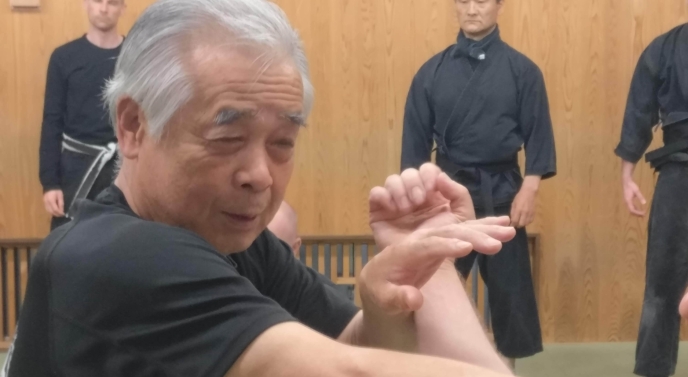From Shiro Kuma by kumafr

During the break, I asked Sensei for calligraphy to use it as a logo for the Paris Taikai next July.
He made up “Ninkū,” a pun with the word “Ninku,” but written with “Kū.” instead of “Ku.” If “Ninku” exists, and means “endurance.” (1) “Ninkū with a long “ū” doesn’t. It was made by Sensei, associating “Shinobi” and “Kū.” (2) (3) He replaced “endurance” by “stealthy emptiness.” And it is like what Sensei is showing in class. His movements are so empty that Uke falls into the void.
The Mutō Dori of 2019 is now dealing with a lack of presence. There is nothing to see and nothing to feel. The control of the attacker results of a lack of control. In a recent post, I introduced you to Mutōsei, “uncontrolled.” (4) To me, Ninkū is precisely this feeling. Sensei controls you without control. As if he was able to express the emptiness itself.
Like many high-level feelings, it is difficult to express it with words even if you had the chance to feel it from Sōke. Buddhism, says that you can share Satori, only with those who experienced it. I guess this is the same. (5)
If you watch Sensei from the outside, it looks like magic. This is why he asks his Uke to explain their feeling after the technique.
Ninku, (1) also means Stoicism, it also seems correct. To succeed in Budō, you have to endure a lot of pain and disillusions. The training is about endurance. It has no end. We begin to practice one day for the wrong reasons, and we stay without knowing exactly why. This is pure Stoicism.
Noguchi sensei told me once that in the old days Sensei was quite brutal. He was so violent in training that the wooden floor under the mats would sometimes break! When it happened, they would stop the practice, get the tools, repair it, and go back to train. Sensei repeats that he doesn’t teach us. But it seems that this “non-teaching” of him, started a long time ago. Noguchi sensei said that Sōke used them as Guinea pigs. Sensei wanted to learn the techniques he was receiving from Takamatsu sensei by mail. (6)
Noguchi sensei admitted that twice he nearly quit unable to see the need for so much pain.
When you see how good he is today, I guess that staying in the Bujinkan was the right decision. He “endured” the pain to become one of the best teachers of the Bujinkan. And the same applies to the first generation of Sensei’s students.
We can now see more with clarity that Ninku is the Omote, and Ninkū is the Ura. I will share this new feeling in my next seminars, and at the Paris Taikai in July.
Sōke said recently that it takes 10 years of hard training, passing through a lot of hardship to study basics. So how many years do we need to get to Ninku and Ninkū?
We have to be resilient and cultivate our patience!
1 忍苦, Ninku: endurance; Stoicism
2 忍び, Shinobi: stealth, traveling incognito, ninjutsu, ninja, sneak theft; sneak thief, tolerance
3 空, Kū: empty air; sky, Shunya (emptiness, the lack of an immutable intrinsic nature within any phenomenon). Meaninglessness, void (one of the five elements)
4 無統制, Mutōsei: uncontrolled
5 悟り, Satori: enlightenment; spiritual awakening; understanding, comprehension
6 Sensei was visiting Takamatsu Sensei every two months (and not every two weeks as the legend says). He had the scrolls with him. Between visits, Takamatsu was sending two letters per week with many technical details.



